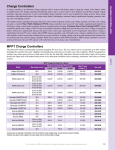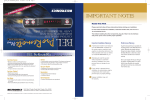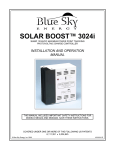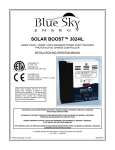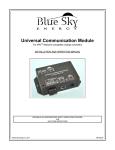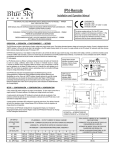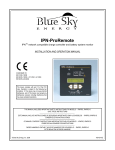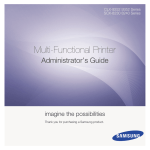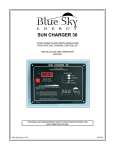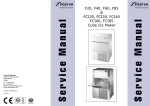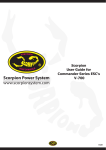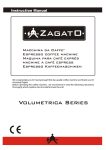Download BLUE SKY SUB 12 Troubleshooting guide
Transcript
SOLAR BOOST™ 2512i(X)-HV 20/25AMP 12VDC MAXIMUM POWER POINT TRACKING PHOTOVOLTAIC CHARGE CONTROLLER INSTALLATION AND OPERATION MANUAL THIS MANUAL INCLUDES IMPORTANT SAFETY INSTRUCTIONS FOR MODELS SB2512i-HV and SB2512iX-HV, SAVE THESE INSTRUCTIONS. THIS MANUAL DOES NOT APPLY TO EARLIER MODELS SB2512i OR SB2512iX COVERED UNDER ONE OR MORE OF THE FOLLOWING US PATENTS 6,111,391 • 6,204,645 © Blue Sky Energy, Inc. 2012 430-0033 B Blue Sky Energy - Solar Boost 2512i-HV and 2512iX-HV TABLE OF CONTENTS IMPORTANT SAFETY INSTRUCTIONS ................................................................................................................................ 2 PRODUCT DESCRIPTION...................................................................................................................................................... 3 Features Omitted in the Solar Boost 2512i-HV ...................................................................................................... 3 Part Numbers and Options ..................................................................................................................................... 3 OPERATION ......................................................................................................................................................................... 3 Charge Status Indicator.......................................................................................................................................... 3 Auxiliary Output Indicator ....................................................................................................................................... 3 Optional Remote Displays or Internet Communication .......................................................................................... 3 3-Stage Charge Control ......................................................................................................................................... 4 Bulk Charge ................................................................................................................................... 4 Absorption Charge ......................................................................................................................... 4 Float Charge .................................................................................................................................. ..4 2-Stage Charge Control ......................................................................................................................................... 4 Equalization ............................................................................................................................................................ 4 Current Limit ........................................................................................................................................................... 5 Optional Temperature Compensation .................................................................................................................... 5 Maximum Setpoint Voltage Limit ............................................................................................................................ 5 Maximum Power Point Tracking (MPPT) ............................................................................................................... 5 Panel Temperature and Output Power................................................................................................................... 5 Multiple Charge Controllers On The IPN Network.................................................................................................. 5 INSTALLATION....................................................................................................................................................................... 5 Electrostatic Handling Precautions......................................................................................................................... 6 Selecting PV Modules ............................................................................................................................................ 6 As Shipped Factory Default Settings...................................................................................................................... 6 Equalize Enable ..................................................................................................................................................... 6 Battery Temperature Sensor .................................................................................................................................. 6 Battery and PV Wiring ............................................................................................................................................ 7 Auxiliary Output ...................................................................................................................................................... ..7 Auxiliary Battery Charge ................................................................................................................ 8 Load Controller............................................................................................................................... 8 Dusk-to-Dawn Lighting Control ...................................................................................................... 8 Installing a Multi-Controller System ........................................................................................................................ 8 Multi-Controller Wiring And Setup .................................................................................................. 8 IPN Network Address ..................................................................................................................... 9 Mounting ................................................................................................................................................................. 9 TROUBLESHOOTING GUIDE ................................................................................................................................................ 10 SPECIFICATIONS ................................................................................................................................................................... 11 5-YEAR LIMITED WARRANTY .............................................................................................................................................. 11 TABLES AND FIGURES Table 1 Table 2 Figure 1 Figure 2 Figure 3 Figure 4 Figure 5 Figure 6 1 Charge Status Indicator ................................................................................................................. 3 Maximum Conductor Length - 3% Voltage Drop............................................................................ ..7 Front Panel Indicators .................................................................................................................... 4 Factory Charge Voltage Setpoint -vs.- Battery Temperature ......................................................... 5 Setup and Wiring Diagram ............................................................................................................. 7 Auxiliary Output Wiring................................................................................................................... 8 IPN Network Wiring ........................................................................................................................ 9 Detailed Dimensional Drawing ....................................................................................................... 9 Installation and Operation Manual IMPORTANT SAFETY INSTRUCTIONS This manual contains important instructions for Models SB2512i-HV and SB2512iX-HV SAVE THESE INSTRUCTIONS 1. Refer installation and servicing to qualified service personnel. High voltage is present inside unit. Incorrect installation or use may result in risk of electric shock or fire. No user serviceable parts in this unit. 2. To reduce the risk of electric shock, fire or personal injury, the following symbols are placed throughout this manual to indicate dangerous conditions, or important safety or operational instructions. WARNING CAUTION IMPORTANT ) Indicates dangerous conditions or electric shock potential. Use extreme caution. Indicates items critical to safe installation or operation of the unit. Follow these instructions closely for proper operation of the unit. 3. PERSONAL PRECAUTIONS a) Working in the vicinity of lead-acid batteries is dangerous. Batteries produce explosive gasses during normal operation. b) To reduce risk of battery explosion, follow these instructions and those published by battery manufacturer and manufacturer of any equipment you intend to use in vicinity of battery. c) Someone should be within range of your voice or close enough to come to your aid when you work near a lead-acid battery. d) Have plenty of fresh water and soap nearby in case battery acid contacts skin, clothing or eyes. e) Wear complete eye protection and clothing protection. Avoid touching eyes while working near battery. f) If battery acid contacts skin or clothing, wash immediately with soap and water. If acid enters eye, immediately flood eye with running cold water for at least 15 minutes and get medical attention immediately. g) NEVER SMOKE or allow a spark or flame in vicinity of battery. h) Be extra cautious to reduce risk of dropping metal tool onto battery. It might spark or short circuit battery or other electrical part that may cause explosion. i) Remove personal metal items such as rings, bracelets and watches when working with a lead-acid battery. A lead-acid battery can produce a short circuit current high enough to weld a ring or the like to metal, causing a severe burn. j) Remove all sources of power, photovoltaic and battery before servicing or installing. 4. CHARGER LOCATION & INSTALLATION a) This unit is designed to charge 12V (6 cell) flooded or sealed type lead-acid chemistry batteries within the range of 10 to 2,000 amp-hours. Follow battery manufacturers charging recommendations when considering this unit for use with other battery chemistry. b) This unit employs components that tend to produce arcs or sparks. NEVER install in battery compartment or in the presence of explosive gases. c) This unit must be installed and wired in accordance with National Electrical Code, ANSI/NFPA 70. d) Over current protection for the battery must be provided externally. To reduce the risk of fire, connect to a circuit provided with 30 amperes maximum branch-circuit over current protection in accordance with National Electrical Code, ANSI/NFPA 70. e) Over current protection for the auxiliary load control output or auxiliary battery charge output must be provided externally. To reduce the risk of fire, connect to load or auxiliary battery with 30 amperes maximum over current protection in accordance with National Electrical Code, ANSI/NFPA 70. f) Insure that unit is properly configured for the battery being charged. g) This unit is not water tight. Do not expose to rain, snow or excessive moisture. h) Insure all terminating connections are clean and tight. Battery, PV and Auxiliary Output terminals are to be tightened to 9 in-lb (1 nm). IPN Network and battery temperature sensor compression terminals are to be tightened to 2.1 in-lb (0.24 nm). i) Do not connect to a PV array capable of producing greater than 20 amperes of short circuit current @ STC. j) This unit is not provided with a GFDI (ground-fault detector/interrupter) device and must be used with an external GFDI device as required by Article 690 of National Electrical Code for the installation location. 5. PREPARING TO CHARGE a) Never charge a frozen battery. b) Be sure battery is mounted in a well ventilated compartment. c) Add distilled water in each cell of a lead-acid battery until battery acid reaches level specified by battery manufacturer. 2 Blue Sky Energy - Solar Boost 2512i-HV and 2512iX-HV PRODUCT DESCRIPTION Solar Boost™ 2512i-HV and 2512iX-HV are improved versions of the original SB2512i and SB2512iX 12 volt 25 amp Maximum Power Point Tracking (MPPT) photovoltaic (PV) battery charge controllers. The new HV versions retain their original 25 amp 340 watt rating when used with conventional 12 volt 36 cell PV modules, but are also able to operate up to 270 watts of higher voltage 60 cell “grid tie” type modules. The full featured SB2512iX-HV includes all the features described in this manual. The SB2512i-HV omits certain features to reduce cost. The 2512’s patented MPPT technology can increase charge current up to 30% or more compared to conventional controllers. MPPT also allows the use of higher voltage 60 cell modules by converting higher PV voltage down to charge a 12 volt battery. The 2512’s sophisticated 3-stage charge control system improves battery performance and life while minimizing battery maintenance. The unit is fully protected against voltage transients, over temperature, over current and reverse polarity. The IPN Network display connector provided in both versions allow use of optional remote displays or a UCM. Additional features included in the SB2512iX-HV version of the product include a battery temperature sensor input, equalization capability, full IPN Network interface, and an auxiliary output. The versatile auxiliary output can operate as either a 2 amp battery charger for a second battery, or serve as a 25 amp load controller or 25 amp variable Dusk-to-Dawn lighting controller. The full IPN Network interface included in the SB2512iX-HV allows multiple charge controllers to communicate with each other and coordinate their activity to charge the battery as a single coordinated charging machine. FEATURES OMITTED IN THE SOLAR BOOST 2512i-HV The following features described in this manual are omitted in the lower cost Solar Boost 2512i-HV version of the product. • Battery Temperature sensor input • Full IPN Network interface (multi-controller coordination) • Battery equalization capability • Auxiliary Output (25A load & lighting control, or 2A auxiliary battery charge) PART NUMBERS AND OPTIONS • SB2512i-HV ....... Basic Solar Boost 2512i-HV charge controller • IPNPRO-S .......... IPN-ProRemote display & battery monitor w/shunt • CS-500 ............... 500A/50mV current shunt • 930-0022-20 ....... Battery temperature sensor • SB2512iX-HV ..... Full featured Solar Boost 2512iX-HV charge controller • IPNPRO .............. IPN-ProRemote w/o required 500A/50mV shunt • IPNREM ............. IPN-Remote display • UCM ................... Universal Communication Module OPERATION Charge control and MPPT operations are fully automatic. At night when PV power production stops, the PV array is disconnected from the battery to prevent unwanted current drain. There is a 5 second turn-on delay, and a 45 second turn-off delay. ¾ WARNING: The 2512 operates on battery power, not PV power. A battery must be connected with a minimum voltage of 9V for the unit to operate. Battery voltage on the battery terminals of the 2512 must be the same as actual battery voltage within a few 10ths of a volt for proper operation. DO NOT disconnect the battery with PV power applied as appliances still attached to the output of the 2512 may be damaged by voltage spikes resulting from sudden removal of the battery, particularly when used with higher voltage 60 cell PV modules. ALWAYS remove PV power first before disconnecting the battery. CHARGE STATUS INDICATOR A charge status indicator is provided on the face of the 2512, and on the optional remote displays. If net battery charge current is greater than ≈3 to 5 amps per 100 amp-hours of battery capacity the charge status indicator can provide a rough indication of battery state of charge. CHARGE STATUS INDICATOR CHARGE STATUS INDICATOR OFF CONTINUOUSLY ON BLINKING • 1 SEC ON / 1 SEC OFF BLINKING • 0.2 SEC ON / 1 SEC OFF RAPID BLINKING • 0.2 SEC ON / 0.2 SEC OFF CHARGE MODE CHARGE OFF BULK ABSORPTION FLOAT EQUALIZE APPROXIMATE CHARGE LEVEL <70% FULL 70% - 95% FULL FULLY CHARGED TABLE 1 AUXILIARY OUTPUT INDICATOR (Omitted on SB2512i-HV) An Auxiliary Output indicator labeled “LOAD” is provided on the face of the SB2512iX-HV, and is omitted on the SB2512i-HV. The indicator will be ON when the auxiliary output is ON providing power to a load, or charging an auxiliary battery. Default operation of the auxiliary output is Auxiliary Battery Charge and the indicator may turn ON even though an auxiliary battery may not be connected. Auxiliary Output status can also be viewed on the IPN-ProRemote. OPTIONAL REMOTE DISPLAYS OR INTERNET COMMUNICATION There are two available remote displays, the low cost IPN-Remote and the full featured IPN-ProRemote. The IPN-Remote is a basic 3-digit LED type voltage, current and charge mode display without setup or control capability. The full featured IPN-ProRemote provides setup capability and enhanced monitoring of charge controllers on the IPN network. It also provides a complete battery system monitor with various amp-hour counters and a highly accurate “fuel gage” type battery level indicator. A Universal Communication Module (UCM) may also be used for communication with other devices or to access the charge control system remotely over the Internet. 3 Installation and Operation Manual 3-STAGE CHARGE CONTROL The 2512 is factory configured for a 3-stage charging process, Bulk, Absorption and Float. The 3-stage charge process provides a somewhat higher charge voltage to charge the battery quickly and safely. Once the battery is fully charged a somewhat lower voltage is applied to maintain the battery in a fully charged state without excessive water loss. 3-stage charge improves battery performance and life while minimizing battery maintenance. Bulk Charge The 2512 will be in Bulk charge when battery voltage is below the Absorption Charge Voltage setpoint. During Bulk the 2512 delivers as much charge current as possible to rapidly recharge the battery and drive battery voltage up to the Absorption Charge Voltage setpoint. Absorption Charge When the battery recovers sufficient charge for battery voltage to rise to the Absorption Charge Voltage setpoint (factory set to 14.2V) current is reduced as necessary to hold the battery at the Absorption Voltage. The 2512 remains in Absorption until the battery is fully charged as determined by either; 1. 2. The 2512 has remained in Absorption continuously for the Charge Time period (factory set to 2 hours). – – – OR – – – With the IPN-ProRemote display, net battery charge current while in Absorption decreases to the Float Transition Current setting (factory set to 1.5A per 100 amp-hours of battery capacity). Float Charge Once the battery is fully charged a somewhat lower Float Voltage (factory set to 13.2V) is applied to maintain the battery in a fully charged state without excessive water loss. During Float a healthy fully charged lead-acid battery will draw ≈0.1–0.2 amps per 100 amp-hours of battery capacity. 2-STAGE CHARGE CONTROL Certain battery types or system configurations may require 2-stage charge control. The 2512 can be configured for two stage Bulk/Absorption charge control by setting the Float charge voltage setting to No Float using the IPN-ProRemote or UCM. Refer to the IPN-ProRemote or UCM operators manual. FRONT PANEL INDICATORS Charge Status Indicator Shows present charge mode and approximate battery state of charge. The front panel serves as a heatsink for power control devices. It is normal for the front panel to be quite warm to the touch when operating at high power. Auxiliary Output Indicator Shows when auxiliary output is ON for load control or auxiliary battery charge. Omitted in SB2512i-HV version. FIGURE 1 EQUALIZATION (Omitted on SB2512i-HV) ¾ WARNING: Not all batteries can be safely equalized. Equalization should be performed only on vented liquid electrolyte lead-acid batteries. Always follow battery manufacturers recommendations pertaining to equalization. Equalization applies a relatively high voltage producing significant battery gassing. Disconnect equipment that cannot tolerate the high equalization voltage which is temperature compensated as shown in Figure 2. The 2512 can perform automatic equalization alone, or equalization may be controlled manually via the IPN-ProRemote or UCM. Equalization is essentially a controlled overcharge which applies a relatively high voltage to bring all battery cells up to the same specific gravity. While equalization parameters are adjustable with the IPN-ProRemote or UCM, factory default parameters of 15.2V for 2 hours every 30 days are suitable for most applications. A minimum net charge current of approximately 3.5 amps per 100 amp-hours of battery capacity is required for proper equalization. The equalization timer is a “time at voltage” time accumulator. The equalization timer will not count down unless battery voltage reaches the equalization voltage setpoint. Unless manually canceled the 2512 will stay in equalize for as long as necessary to accumulate the required time at voltage. If equalize does not complete by end of the charging day it will resume where it left off the next charging day. If equalize does not complete in a reasonable period of time due to insufficient current it should be canceled manually via the IPN-ProRemote or UCM, or by momentarily removing power to reboot the 2512. 4 Blue Sky Energy - Solar Boost 2512i-HV and 2512iX-HV CURRENT LIMIT If PV input power is high enough to produce more than 25 amps of output current with 36 cell PV modules, or 20 amps with 60 cell PV modules, the 2512 will automatically limit output current to this maximum rating. Note that when the 2512 exits current limit, it will briefly show Absorption on the Charge Status Indicator even though battery voltage may be low. If changing from 60 cell to 36 cell modules reboot the 2512 to restore 25A current limit. OPTIONAL TEMPERATURE COMPENSATION (Omitted on SB2512i-HV) The charge voltage required by batteries changes with battery temperature. Temperature compensation of charge voltage enhances battery performance and life, and decreases maintenance. Automatic temperature compensation can be provided using the optional battery temperature sensor (BSE p/n 930-0022-20). The default compensation factor of –30.0mV/°C (–5.00mV/°C/cell) is appropriate for most lead-acid batteries. FACTORY DEFAULT CHARGE VOLTAGE SETPOINT -VS.- BATTERY TEMPERATURE FIGURE 2 MAXIMUM SETPOINT VOLTAGE LIMIT Maximum voltage setpoint limit places a ceiling or upper limit on the maximum charge voltage. Regardless of setpoint values entered by the user or result from temperature compensation the 2512 will not apply a charge voltage setpoint greater than the maximum voltage setpoint limit factory configured to 15.5V. Note that actual battery voltage may briefly exceed this value by 0.1 – 0.2V as the voltage control system responds to changes in load. MAXIMUM POWER POINT TRACKING (MPPT) The 2512’s patented MPPT technology can increase charge current up to 30% or more compared to PWM controllers operating 36 cell PV modules. Principal operating conditions affecting current boost performance are PV cell temperature and battery voltage, with lower PV temperature and lower battery voltage producing greater charge current increase. In cool comfortable temperatures most systems see about 10 – 20% increase. Increase may go to zero in hot temperatures, whereas charge current increase may easily exceed 30% with a discharged battery and freezing temperatures. MPPT also allows efficient use of higher voltage 60 cell modules by converting their much higher voltage down to battery voltage. Ignoring conversion losses the conversion process produces an output current roughly equal to PV current times the ratio of PV voltage to battery voltage. If a 60 cell module is operating at 23V at 5 amps and battery voltage was 14V, output charge current would be about 5 amps times 23V ÷ 14V or about 8 amps. For a more complete MPPT description see www.blueskyenergyinc.com. PANEL TEMPERATURE AND OUTPUT POWER Internal power control devices use the front panel as a heatsink. It is normal for the front panel to become quite warm to the touch when the unit is operating at high power. When mounted vertically as described in the installation section, the unit can deliver full output in an ambient temperature of up to 40°C (104°F). If an over temperature condition exists, the unit will shut down, the Charge Status Indicator will display an OFF condition, and a remote display will turn off. The 2512 does not include a digital type temperature sensor and will always show the heatsink to be –55°C on the IPN-ProRemote or UCM. MULTIPLE CHARGE CONTROLLERS ON THE IPN NETWORK (Omitted on SB2512i-HV) The IPN network architecture allows multiple charge controllers to operate as a single charging machine. Up to 8 IPN compatible charge controllers can reside on a single network and can share a single display, battery temperature sensor and UCM. Charge controllers can be added to grow a small system into a large system and have this large system operate from the users standpoint as a single charging machine. INSTALLATION ¾ WARNING: Read, understand and follow the Important Safety Instructions in the beginning of this manual before proceeding. This unit must be installed and wired in accordance with National Electrical Code, ANSI/NFPA 70. Over current protection must be provided externally. To reduce the risk of fire, connect to a circuit provided with 30 amp maximum branch-circuit over current protection in accordance with National Electrical Code, ANSI/NFPA 70 with 36 cell modules, or 25 amp maximum with 60 cell modules. Do not connect a PV array capable of delivering greater than 20 amps of short circuit current ISC at STC with 36 cell modules, or 11 amps with 60 cell modules. Do not connect BAT– and PV– together external to the unit. To reduce risk of electric shock or product damage, remove all sources of power before installing or servicing. Figures 3 and 4 show generalized connections only and are not intended to show all wiring, circuit protection and safety requirements for a photovoltaic electrical system. 5 Installation and Operation Manual ¾ CAUTION: The 2512 is protected against reverse battery and PV polarity, and swapped PV and battery connections, but will be damaged by reverse battery to the PV terminals. Transient voltage lightning protection is provided, but steady state voltage in excess of 50VDC on the battery or PV terminals will damage the unit. Damage of either type voids the limited warranty. ELECTROSTATIC HANDLING PRECAUTIONS All electronic circuits may be damaged by static electricity. To minimize the likelihood of electrostatic damage, discharge yourself by touching a water faucet or other electrical ground prior to handling the 2512 and avoid touching components on the circuit boards. The risk of electrostatic damage is highest when relative humidity is below 40%. SELECTING PV MODULES The 2512 is designed to operate conventional 12V 36 cell PV modules or higher voltage 60 cell modules. If multiple PV modules are used best MPPT current boost performance will be obtained if all PV modules are identical. Dissimilar modules should have VMP values within ≈0.5V or better and be of the same basic cell technology so their VMP will tend to track as operating conditions change. If module types are very different consider using a separate charge controller for each module type to obtain the best MPPT current boost performance. When multiple controllers are used on the IPN Network each controller independently MPPT’s their modules to their best. Do not mix 36 cell and 60 cell modules on the same controller. Select PV modules that do not exceed the maximum ratings shown below, and preferably produce IMP of at least 3.5 amps (2 amps with 60 cell modules) per 100 amp-hours of battery capacity. Voltage, current and power produced by PV modules fluctuate widely with operating conditions. As a result a set of test conditions referred to as Standard Test Conditions (STC) are used to rate modules in a meaningful manner and accurately predict real world performance. STC ratings are not maximum or optimal ratings. Conditions can be present where VOC and ISC approach 1.25 times STC ratings which is why National Electrical Code and our recommendations call for 1.25 derating of both VOC and ISC. Yet in real world conditions IMP actually seen is commonly only about 75 – 80% of IMP at STC. Key PV module specifications; PMAX Maximum power in watts (PMAX = VMP x IMP) VOC Voltage with module open circuit (typically ≈20 – 22V for 12V nominal 36 cell modules) VMP Voltage where module produces Maximum Power (typically ≈17 – 18V for 12V nominal 36 cell modules) Current where module produces Maximum Power IMP Current with module Short Circuit ISC PV Cell Count 36 Cell 60 Cell Maximum PV Power @ STC 340W 270W Automatic Output Current Limit 25A 20A Maximum PV Isc @ STC 20A 11A Maximum PV VOC @ STC 24.0V 40.0V Recommended range of VMP @ STC 16.0 – 19.0V 24.0V – 31.0V AS SHIPPED FACTORY DEFAULT SETTINGS ) ¾ The 2512 contains various user configurable settings all of which are preconfigured at the factory. Most installations require no changes to these settings which are typically suitable for most lead-acid batteries including sealed lead-acid batteries such as Gel and AGM. All software programmable settings require an IPN-ProRemote or UCM to change and are retained if power is lost or the IPN-ProRemote or UCM are used as setup tools only and removed. Software programmable settings; • Charge mode .............................................. 3-stage • Absorption voltage ...................................... 14.2V • Float voltage ................................................ 13.2V • Charge time ................................................ 2.0 hours • Float Transition Current .............................. 1.5A/100 amp-hours • Load control ON voltage ........................... 12.6V • Load control OFF voltage ......................... 11.5V • • • • • • Equalize voltage ....................................................... 15.2V Equalize time ............................................................ 2.0 hours Auto equalize days ................................................... 30 days Maximum voltage setpoint limit ................................ 15.5V Temperature compensation factor ........................... −5.00mV/°C/cell Dusk-to-Dawn lighting control ............................... . Disabled DIP switch & jumper settings; (All DIP’s OFF, A2 open – Omitted on SB2512i-HV) • Auxiliary Output mode ................................ Auxiliary battery charger • IPN Network address ............................................... 0 (zero) • Equalize ...................................................... Disabled EQUALIZE ENABLE (Omitted on SB2512i-HV) If DIP switch #4 is turned OFF equalization is completely disabled regardless of other equalization settings. If DIP switch #4 is turned ON prior to the application of battery power, automatic equalization is enabled and the SB2512iX will perform automatic equalization after the set number of Auto Equalize Days has elapsed. If DIP switch #4 is turned ON, after battery power is applied an equalization cycle will begin immediately. Equalization start/stop may also be remotely controlled from the IPN-ProRemote or UCM. BATTERY TEMPERATURE SENSOR (Omitted on SB2512i-HV) Installation of the optional battery temperature sensor enables temperature compensation of all charge voltage setpoints. In a multi-controller system only one temperature sensor is required and must connect to the IPN Master, IPN address 0 (zero). DO NOT attach a sensor or connections other than Blue Sky Energy battery temperature sensor p/n 930-0022-20. Be certain to observe proper RED/BLK polarity. If a valid temperature sensor signal is not detected the 2512 will operate as if battery temperature is 25°C. 6 Blue Sky Energy - Solar Boost 2512i-HV and 2512iX-HV BATTERY AND PV WIRING A desirable installation will produce a total system wiring voltage drop of 3% or less. The lengths shown in Table 2 are one way from the PV modules to the battery with the 2512 located along the path. Length can be increased inversely proportional to actual PV IMP such that if current was reduced by 1/2 wire lengths could be doubled and still provide the same 3% voltage drop. For 60 cell modules use one wire size larger than shown (smaller awg #) for the wire section between the 2512 and the battery. MAXIMUM CONDUCTOR PAIR LENGTH – 3% VOLTAGE DROP WIRE GAUGE AWG 12 AWG 10 AWG 8 AWG 6 AWG 4 AWG 60 CELL MODULES @11AMP INPUT FEET / METERS 19.2 / 5.7 30.6 / 9.3 48.6 / 14.7 77.1 / 23.4 122.4 / 37.5 36 CELL MODULES @ 20AMPS INPUT FEET / METERS 6.4 / 1.9 10.2 / 3.1 16.2 / 4.9 25.7 / 7.8 40.8 / 12.5 TABLE 2 ¾ CAUTION: Battery, PV and Auxiliary Output terminal block accept #20−10 AWG wire and are to be tightened to 9 in-lb (1 nm). IPN Network and Temperature Sensor compression terminals accept #24−14 AWG wire and are to be tightened to 2.1 inlb (0.24 nm). ¾ CAUTION: DO NOT connect Bat– and PV– together outside of the unit or improper operation will result. Bat– and PV– connect together internally. PV– must connect directly into the 2512 and not to other negative buss bars or grounds. SETUP AND WIRING DIAGRAM FIGURE 3 AUXILIARY OUTPUT (Omitted on SB2512i-HV) The auxiliary output can serve one of three functions; a 2 amp auxiliary battery charger, a 25 amp Low Voltage Disconnect (LVD) load controller, or a 25 amp variable Dusk-to-Dawn lighting load controller with LVD. The Charge/Load function is selected by DIP switch #3 shown in Figure 3. The IPN-ProRemote or UCM are required to adjust LVD thresholds or enable Dusk-to-Dawn lighting control. Auxiliary outputs in a multi-controller system will function separately, but only the auxiliary output in the master can be configured or monitored. The auxiliary output Load Indicator will illuminate whenever the auxiliary output is ON. ¾ CAUTION: The auxiliary output cannot perform both auxiliary battery charge and load control functions at the same time. Do not connect to the 25 amp Load terminal for auxiliary battery charge or the 2512 may be damaged in a manner that voids the warranty. 7 Installation and Operation Manual AUXILIARY BATTERY CHARGE – DIP #3 OFF The auxiliary charge function is used to charge an auxiliary battery of the same voltage as the primary battery. If the primary battery is charging in Absorption or Float, up to 2 amps is diverted to the auxiliary battery at the same charge voltage. Auxiliary battery charge is disabled during Bulk or Equalization. Use 14 awg wire to minimize voltage drop and 25 amp maximum over current protection. Auxiliary battery negative must connect to primary battery negative. AUXILIARY OUTPUT WIRING FIGURE 4 LOAD CONTROLLER – DIP #3 ON The load controller can deliver up to 25 amps of output and operates as a high side switch to battery positive. Default settings are for Low Voltage Disconnect (LVD) with ON at VBAT ≥12.6V, and OFF at VBAT ≤11.5V, which can be changed with the IPN-ProRemote or UCM. ON/OFF operation can also be based on battery amp-hours from full if an IPN-ProRemote is permanently installed. The ON/OFF condition must be valid for 20 seconds before switching will occur. If the higher/lower values are reversed the output control logic is inverted. ¾ CAUTION: 30 amp maximum over current protection for the output must be provided externally. If the load control is configured to operate based on net battery amp-hours, configure ON/OFF voltage thresholds as well. If amp-hour from full data is not available, voltage based operation will resume. ON/OFF thresholds must not be the same value or improper operation will result. DUSK-TO-DAWN LIGHTING CONTROL – DIP #3 ON An IPN-ProRemote with software version V2.00 or later or a UCM is required to setup and enable lighting control. Refer to IPN-ProRemote or UCM operators manual for lighting control setup instructions. Variable time settings are available to turn lighting ON after Dusk (Post-Dusk timer) and/or ON before Dawn (Pre-Dawn timer). If both timers are set to DISABLED (factory default), the lighting control feature is disabled. If either the Post-Dusk or Pre-Dawn timers are set to a time value the lighting control feature is enabled. When lighting control is enabled the Load output is controlled by both the normal LVD control function and the lighting control function such that whichever function wants the Load output OFF prevails. Dusk or night time begins when the charge control system turns OFF which occurs when PV module current drops below ≈50mA at battery voltage. Dawn or day time begins when the charge control system turns ON which occurs when PV module current rises to ≈100mA at battery voltage. If the Post-Dusk timer was set to 1.0 hour and the Pre-Dawn timer was set to 2.0 hours, lights would turn ON at Dusk, remain ON for one hour, and then turn OFF. Two hours before Dawn the lights would again turn ON and remain ON until Dawn. For full Dusk to Dawn lighting set the Post-Dusk timer to 20 hours. When the 2512 first receives battery power it does not know when Dawn is expected to occur. As a result Pre-Dawn control does not operate for the first night. Once a night time period of 4 hours or more is detected this night time period is stored and Pre-Dawn control will operate. Each subsequent night time period greater than 4 hours is added to a filtered average of night time so that the predicted night time period automatically adjusts to changing seasons. INSTALLING A MULTI-CONTROLLER SYSTEM (Omitted on SB2512i-HV) A communication link is established between controllers by daisy chaining a twisted pair cable from the IPN Network terminal block, controller to controller (A-to-A, B-to-B) as shown in Figure 5. Up to 8 IPN based charge controllers can be connected together in a multi-controller system. Device address 0 (zero) is the master and 1 – 7 are slaves. The master controls the charging process and directs the activities of the slaves. MULTI-CONTROLLER WIRING AND SETUP ¾ CAUTION: A multi-controller system requires the following specialized installation and setup: 1) Each controller must connect to and charge the same battery. 2) One controller must be set to IPN address 0 (zero) and the others be set to addresses 1 – 7 with no controllers set the same. 3) Charge parameters are set in the master only. 4) While outputs connect in parallel to a common battery, PV inputs must be completely separate. A large PV array must be divided into sub-arrays, each with separate PV+ and PV– wiring. 5) All controllers must be connected to the IPN network as shown in Figure 5. 8 Blue Sky Energy - Solar Boost 2512i-HV and 2512iX-HV IPN NETWORK WIRING FIGURE 5 IPN Network Address – DIP’s #1, #2 & Jumper A2 ) ¾ A single controller must be set to IPN network address 0 (zero). In a multi-controller system one controller must be set to address 0 (zero) to serve as the master. The other controllers must be set to address 1-7 with no two controllers set the same. The 2512 requires that a jumper be soldered across location A2 to select addresses 4 through 7. DIP SWITCH JUMPER (A2) # 1 (A1) # 2 (A0) MASTER 0 NO OFF OFF 1 NO OFF ON IPN NETWORK ADDRESS SLAVES 2 3 4 NO NO YES ON ON OFF OFF ON OFF 5 YES OFF ON 6 YES ON OFF 7 YES ON ON MOUNTING ¾ CAUTION: Mount the 2512 vertically to promote air flow and do not enclose in a confined space. The 2512 is not watertight and must be protected from rain, snow and excessive moisture. The 2512 may also be installed in a standard 411/16” square galvanized electrical box. An optional black powder coated deluxe metal mounting box is also available. If a metal box is used DO NOT remove or install into mounting box with power applied as damage resulting from shorting to the mounting box will void the limited warranty. DETAILED DIMENSIONAL DRAWING FIGURE 6 9 Installation and Operation Manual TROUBLESHOOTING GUIDE SYMPTOM Completely dead, optional display blank Unit will not switch to a Charge ON (charge status indicator OFF), Remote display if attached turns ON. Charge status indicator ON., but no output charge current Charge status indicator blinks rapidly Charge OFF at high ambient temperature Charge current is lower than expected, PV current may be low as well MPPT Current boost is less than expected PROBABLE CAUSE No battery power PV disconnected or low in voltage ITEMS TO EXAMINE OR CORRECT Battery disconnected, overly discharged, or connected reverse polarity. Battery powers the 2512, not PV. PV must supply 0.10 amps at greater than battery voltage to begin charge. PV reverse polarity Reverse polarity PV will cause front panel to heat. IPN network address set wrong A single unit must be set to IPN network address 0 (zero). One unit of a multi-unit network must be set to IPN network address 0 (zero), AND all other units must be set to different addresses. Microprocessor lockup Battery voltage greater than charge voltage setpoint Momentarily remove all power (battery & PV) to reboot. This is normal operation. Output is off due to high battery voltage which may be caused by other charging systems. Battery voltage too low Battery voltage must be at least 9V for the 2512 to operate. PV- connected to BAT- external to controller System in equalize mode PV- & BAT- must be separate for proper operation. PV- must receive earth ground via shunts inside the 2512 which internally connect PV- to BAT-. External connection prevents proper operation of current measurement system. Disable equalize via IPN-ProRemote, or by turning DIP switch #4 off. System temporarily shuts down due to high heat sink temperature Battery is highly charged Improve ventilation or reduce PV power. Sufficient ventilation to prevent over temperature shut down will improve reliability. See Technical Bulletin #100206. Normal operation, current is reduced if in Absorption or Float to control battery voltage. Worn out or dissimilar PV modules Replace, or use as is. Low insolation Atmospheric haze, PV’s dirty or shaded, sun low on horizon, etc. PV- connected to BAT- PV- & BAT- must be separate for proper operation. PV- must receive earth ground via shunts inside the 2512 which internally connect PV- to BAT-. External connection prevents proper operation of current measurement system. PV’s with low VMP. PV’s with VMP ≥ 17V work best, PV’s with <36 cells tend to work poorly. PV maximum power voltage (VMP) is not much higher than battery voltage, leaving little extra power to be extracted Excessive PV wiring voltage drop due to undersize wiring, poor connections etc. Battery is nearly charged and battery voltage is high. Output during MPPT operation is “constant power” such that higher battery voltage reduces charge current increase. Auxiliary battery not being charging System appears OK, but will not correctly switch between Bulk, Absorption & Float Load control not working properly Dusk-to-Dawn feature, lights will not turn ON or remain ON Dusk-to-Dawn feature, lights will not turn OFF PV’s hot VMP and available power decrease with increasing PV cell temperature. Cooler PV’s will produce greater boost. It is normal for % increase to drop or even go to zero as PV temperature rises. Worn out or dissimilar PV modules Not configured for auxiliary battery charge Replace, use as is, or use different controller for different PV modules. Confirm dip switch #3 is OFF. Primary battery not highly charged Auxiliary battery will not receive charge unless primary battery is in Absorption or Float. Load on Auxiliary battery too high Not set for 3 stage charge Maximum auxiliary charge current is roughly 2 amps. Load may need to be reduced. Double check Float voltage setpoint. Will not switch out of Bulk and into Absorption or Float Battery is so discharged that available net charge current cannot bring battery voltage up to the desired charge voltage setpoint. PV power may be too low or loads too high. Will not switch from Absorption to Float Auxiliary output not set for load control Battery not fully charged. Unit will not switch to Float until battery voltage remains at the Absorption voltage setpoint continuously for the Charge Time period (or net battery current drops to the Float Transition Current setpoint if using IPN-ProRemote). Confirm dip switch #3 is ON. Output may have shut off due to low battery charge Load will shut off if battery voltage drops below OFF threshold (default 11.5V). Once shut off, the load will not come back on until battery voltage is above ON threshold (default 12.6V). ON/OFF thresholds set incorrectly Auxiliary output not set for load control Correct ON/OFF threshold settings. Confirm dip switch #3 is ON and Dusk-to-Dawn enabled. Output may have shut off due to low battery charge Load will shut off if battery voltage drops below OFF threshold (default 11.5V). Once shut off, the load will not come back on until battery voltage is above ON threshold (default 12.6V). Charge control system ON Lights will not turn on if charge control system is ON and charging as this is day time. Timers set incorrectly Check time settings Post-Dusk or Pre-dawn timer. Valid night time period not seen Auxiliary output not set for load control Pre-Dawn lighting will not operate until a valid night time period of ≥4 hours detected. If PV was removed/reconnected, night time period may be inaccurate. Remove & restore power to reboot Confirm dip switch #3 is ON and Dusk-to-Dawn enabled. Timers set incorrectly Either Post-Dusk or Pre-dawn timers must be set to time value to enable Dusk-to-Dawn feature. Charge control does not turn ON Check charge control system related items 10 Blue Sky Energy - Solar Boost 2512i-HV and 2512iX-HV SYMPTOM Networked units do not seem to coordinate action or slaves do not turn on Temperature related functions do not work. PROBABLE CAUSE IPN network address set wrong ITEMS TO EXAMINE OR CORRECT One unit of a multi-unit network must be set to IPN network address 0 (zero), AND all other units must be set to different addresses 1 – 7. Network wiring problem Confirm wiring correctly in place. Use IPN-ProRemote or UCM to see View Charge Unit Status screens to confirm communication with slaves. Temperature sensor must be installed on the master in a multi-controller system. Temperature sensor not installed on master Temperature sensor failed, reverse polarity, or not BSE sensor p/n 930-0022-20. If sensor is open, short, reverse polarity, wrong sensor or missing system will operate as if sensor was at 25°C. Sensor temperature can be read directly on the IPN-ProRemote or UCM. Proper sensor voltage when excited by the 2512 will be 2.98V at 25°C, changing at +10mV/°C. SPECIFICATIONS SPECIFICATIONS Output Current Limit Nominal Battery Voltage PV Input Voltage PV Input Power Power Consumption Charge Algorithm Absorption / Float Voltage Power Conversion Efficiency Physical Configuration and Dimensions Analog Input Accuracy / Range Communication Environmental SB2512i-HV 25 amp maximum 36 cell modules • 20 amp maximum 60 cell modules 12VDC 50VDC absolute maximum (Recommend maximum VOC at STC ≤ 40VDC) Recommended maximum, 340W with 36 cell modules / 270W with 60 cell modules 0.30W typical standby • 1.0W typical charge ON 3-stage Bulk/Absorption/Float • Charge time in Absorption fixed at 2 hours (Range 0 – 10 hoursc) 14.2VDC / 13.2VDC fixed value (10.0 – 20.0VDCc) 96% typical @ 14 volt 20 amp output with 36 cell modules Open frame construction with conformal coated electronics mounted to rear of 5.3” x 5.3” (13.5cm x 13.5cm) clear anodized aluminum face plate. Black ABS corrosion proof mounting box included, 2.5” (6.4cm) deep. Battery / PV voltmeters, 35.0VDC / 55.0VDC ±0.50% FS • Input / Output ammeters, 30.0 amps ±0.50% FS IPN Network connector for IPN displays & UCM only. Complete IPN interface for multi-controller coordination not provided. -40 – +40°C, 10 – 90% RH non-condensing Additional Specifications for SB2512iX-HV Equalization Voltage / Time 15.2VDC fixed value (range 10.0 – 40.0VDCc) • Automatic fixed at 2 hours each 30 days, may be disabled Auxiliary Output Functionality Single output field configurable as either: 25 amp load controller –or– 2 amp auxiliary battery charger • Aux. Battery Charge 2 amp typical, same charge voltage as primary battery • Load Control 25 amp maximum; ON @ ≥12.6VDC / OFF @ ≤11.5VDC (Range 10.0 – 40.0VDCc), or net battery amp-hoursc) • Lighting Controlc Variable Post-Dusk and Pre-Dawn timersc, Range 0.5 – 20.0 hours Temperature Compensation Optional battery temperature sensor, -5.00 mV/°C/cell correction factor (Range -0.00 – -8.00 mV/°C/cellc) • sensor range -60 – +80°C Auxiliary Battery Voltage Auxiliary battery voltmeter, 35.0VDC ±0.50% FS Communication Complete IPN Network interface. Allows up to 8 IPN capable controllers to set up and operate as a single charging machine. c As a part of our continuous improvement process With IPN-ProRemote or UCM which may be specifications are subject to change without prior notice. used for setup only, or permanently installed. 5-YEAR LIMITED WARRANTY Blue Sky Energy, Inc. (hereinafter BSE), hereby warrants to the original consumer purchaser, that the product or any part thereof shall be free from defects due to defective workmanship or materials for a period of five (5) years subject to the conditions set forth below. 1. This limited warranty is extended to the original consumer purchaser of the product, and is not extended to any other party. 2. The limited warranty period commences on the date the product is sold to the original consumer purchaser. A copy of the original purchase receipt identifying purchaser and date of purchase, must accompany the product to obtain warranty repairs. 3. This limited warranty does not apply to, and future warranty shall become void, for any product or part thereof damaged by; a) alteration, disassembly or application of a foreign substance, b) repair or service not rendered by a BSE authorized repair facility, c) accident or abuse, d) corrosion, e) lightning or other act of God, f) operation or installation contrary to instructions pertaining to the product, or g) cosmetic aging. 4. If BSE’s examination of the product determines that the product is not defective the consumer shall be charged a test and evaluation fee of $20 and be responsible for all transportation costs and insurance related to returning the product to the consumer. The consumer is ultimately responsible for proper installation and operation of the product and BSE’s prior troubleshooting assistance shall not serve as a waiver of the test and evaluation fee. The test and evaluation fee is subject to change without prior notice. 5. If within the coverage of this limited warranty, BSE shall repair or replace the product at BSE’s sole discretion and return the product via standard ground transportation of BSE’s choosing within the continental US. The consumer shall be responsible for all transportation costs and insurance to return the product outside the continental US, and for all transportation costs and insurance related to expedited return of the product. BSE’s liability for any defective product or any part thereof shall be limited to the repair or replacement of the product. BSE shall not be liable for any loss or damage to person or property, or any other damages, whether incidental, consequential or otherwise, caused by any defect in the product or any part thereof. 6. Any implied warranty for merchantability or fitness for a particular purpose is limited in duration to the length of this warranty. 7. To obtain warranty repairs, contact BSE at 760-597-1642 to obtain a Returned Goods Authorization (RGA) number. Mark the outside of the package with the RGA number and return the product, postage prepaid and insured to the address below. The consumer is responsible for all transportation costs and insurance related to returning the product to BSE, and for any shipping damage which may void the warranty or increase the cost of repairs. Blue Sky Energy, Inc. 2598 Fortune Way, Suite K Vista, CA 92081 USA 760-597-1642 • Fax 760-597-1731 • www.blueskyenergyinc.com 11












